You haven’t done any work on your ski fitness, and the season is fast approaching.
Does it matter? Yes, I’m afraid it does. Skiing is an intensely physical activity, and it’s one you’re planning to do for several hours a day, at altitude – probably for six days in a row. And very little of your 21st century life – sitting in traffic, wheeling a shopping trolley round Tesco, arguing with your kids about their homework – will have prepared you for its challenges.
Of course, if all you really want to do is sit on the sundeck of a mountain restaurant with a bottle of Gigondas, then you’ll be okay. But if you love to ski, and want to make the most of each day on the mountain, you’ve got to prep your body.
Fortunately, even two or three weeks of exercise can make a difference. “In an ideal world, we’d recommend following an 8-12 week exercise programme before you go skiing,” says Rob Madden of sports fitness specialists CHHP, who’s also physio to the Canadian snowboarding team. “But two or three weeks’ work will bring benefits, depending on how consistent you are and what kind of exercises your do.”
John Noonan agrees. He’s the former head athletic trainer for Britain’s park and pipe ski team, and is now the strength and conditioning coach at Huddersfield Giants RLFC. “You shouldn’t expect a big increase in muscle strength in a fortnight,” he says. “But research shows that even from short term strength training (ie less than two weeks) the body can make neural adaptations which improve the coordination, timing and speed of muscle contractions.”
“This alone can provide a skier with improved balance and stability, and reduce the risk of injury,” he says.
So now there’s no excuse, is there? Break yourself in gently – having checked with your GP first if you’ve any doubts about your health or existing injuries, or you’re new to exercise programmes. Then, with the thought of the holiday ahead to inspire you, it’s time to knuckle under.
Here, with a little help from the experts, is a five-point plan to improving last-minute ski fitness – and making the most of what fitness you’ve got once you’re on holiday.
1.Work on Your Cardiovascular Fitness
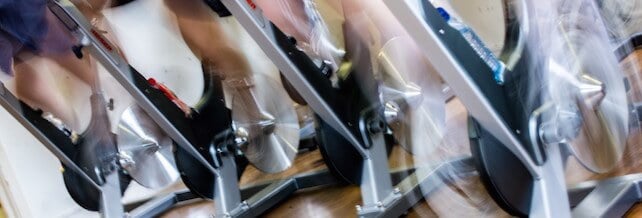
Building cardiovascular fitness will help you ski for longer, and with more power – as well as recover more quickly from your exertions. But you won’t get very far unless you pick an activity you enjoy. “The most important thing with exercise is that a person engages with it and is consistent, and they’re not going to do that with something they hate,” says CHHP’s Rob Madden.
“If someone already jogs and enjoys it, then running makes sense. Or if they’re not comfortable with running they could go for some long brisk walks.” There are in fact several free “Couch to 5K” running programmes available online (such as this one from the NHS), which will help you make the transition between walking and running.
“You also could do something like spinning or circuit classes where you work on an interval basis, increasing your heart rate to a higher level and then easing off,” says Madden. Ideally try to work out three times a week, and – whatever you do – try to vary the intensity of your workout to mimic the on-again, off-again nature of skiing.
Meanwhile, Neil Maclean-Martin, Director of Physiotherapy at La Clinique du Sport in Chamonix, is a fan of Tabata training. “Tabata training is a form of HIIT (High Intensity Interval Training) where you do 20 seconds of intense effort followed by 10 seconds of recovery, and repeated eight times,” he explains.
“It means a total of only three minutes of high intensity work: but a proper course of tabatas over two weeks can bring significant benefits – although you need to leave at least one day’s gap between sessions.” Maclean-Martin has his own tabata programme at befitapps.com.
2.Boost Your Stability, Strength and Coordination
“Skiing is an inherently unstable sport,” says Maxence Legout, a musculoskeletal physiotherapist and rehab trainer at the south London gym, Insight MSK. “You need good balance, and to move you weight very quickly from foot to foot, and so improving your stability is an important preparation for the slopes.”
With that in mind, Maxence has put together a series of exercises which focus on the muscles in the core and the legs. It’s designed as part of a seven-week pre-ski fitness plan which also includes work on your strength and power. But if you’ve only got two or three weeks he suggests focusing all your energy on the stabilisation exercises, working on them for 20-30 minutes, three times a week.
1. Plank: start by getting into a press-up position. Bend your elbows and put your weight onto your forearms and not on your hands. Your body should be in a straight line from shoulders to ankles. Hold your stomach in for a few moments and you should feel the burn!
2. Squats: perform these whilst standing on the squashy side of a BOSU (this piece of equipment looks like a cut-in-half Swiss Ball). If you don’t have a BOSU, then begin with normal squats and progress to one-legged squats.
3. Isometric squats: deep bending of the knees with your back straight against the wall.
4. Swiss ball: Lie on a gym mat with a Swiss Ball under your feet. Roll the ball backwards and forwards – try to control the ball with one foot at a time.
5. Lateral hops: keep both feet parallel and skiing width apart. Try to keep your hands still whilst doing this exercise and do 20 reps of this one.
Many ski fitness specialists also recommend dynamic lunges, which increase the work capacity of your hamstrings and glutes. “Alternating lunges with good alignment of shoulders, hips and foot – and with the knee bending cleanly over the foot – will reduce the crippling muscle soreness on the second and third days of your holiday,” says Neil Maclean-Martin. Check out this demonstration from Ski Total’s own series of ski fitness videos, prepared in collaboration with Godalming Fitness.
3. Warm Up Your Muscles at the Start of the Skiing Day
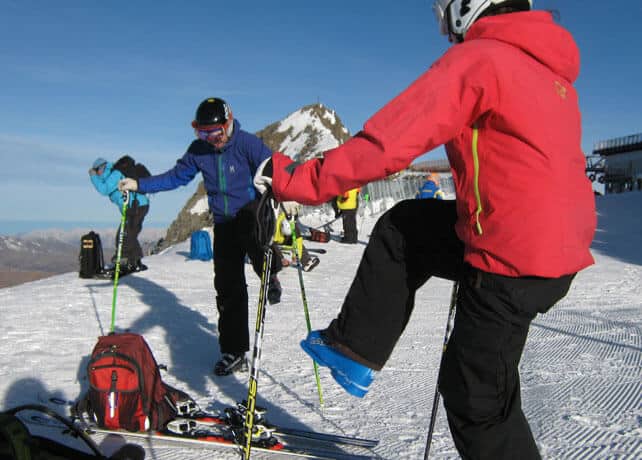
Don’t stop thinking about your fitness when you get to the slopes. “Warming up not only helps to maximise performance,” says Rob Madden. “It can reduce the muscle soreness you feel at the end of the day, and most importantly it may help to reduce your risk of injury.”
“I’d suggest ten minutes of an activity that increases your heart rate and warms the muscles,” he says. “That could be a brisk walk from chalet to pistes each morning, followed by some dynamic stretching – such as arm and leg swings, trunk rotations, lunges and inward and outward hip rotations.” Don’t make the movements too manic: “these should be gentle stretches through the joint’s range of motion,” says Madden.
By the way, he points out that static stretching, when you hold the muscles still, has been shown to have little effect on decreasing the risk of injury or the development of muscle pain.
Meanwhile, Neil Maclean-Martin has put together a short video of warm-up exercises to get the body ready for a day on the slopes. They’re designed to be done when you get off your first lift, before you click into your skis.
ARVE Error: For the maxwidth (maxw) option you need to have normal or lazyload mode enabled, either for all videos in the plugins options or through shortcode e.g. [youtube id=123456 mode=normal maxw=999 ].
4. Know When to Stop
If you’re not super-fit, then you’ve got to know when to call it day on the slopes. Otherwise, you’ll end the day exhausted. You’ll probably develop many skiers know as Day Three Syndrome, too. Half-way through the holiday, you’ll wake up feeling stiff, fuzzy and generally tired, and lose your edge completely for 24 hours.
Knocking off early will also significantly reduce the risk of injury. Neil Maclean-Martin has seen hundreds of knee injuries in his time in Chamonix (“about 50 ACL ruptures per year”), and knows that one of the main causes of them is fatigue.
“Often after lunch you’re tired – and skiing with a different technique, using muscles that are less responsive. So your joints and ligaments are getting less support,” he says. Add to that the tougher conditions – such as bumpy pistes and chopped up powder or slush – and it’s no wonder the end of the day is a prime time for injury. “Listen to your mind and body,” says Maclean-Martin. “Avoid the temptation to have one last run, and finish early, on a high, rather than in an ambulance.”
5. Finish The Day With Some “Active Recovery”
“Active recovery is the name of the game,” says Maclean-Martin. So don’t collapse into the nearest chair in a bar and sink a couple of beers. “Go straight back to your accommodation, and take a ten to fifteen minute walk in normal shoes. This will move the bloody gently through the legs reducing the concentration of harmful chemicals. Follow that with a shower (perhaps adding 30 seconds of super cold water for each leg done three times to really blast the circulation) and finally a quick stretch for the glutes and quads. Then you can go out for your evening entertainment.” This should make your legs feel a lot less stiff and tired .
Ski Fit Specialists
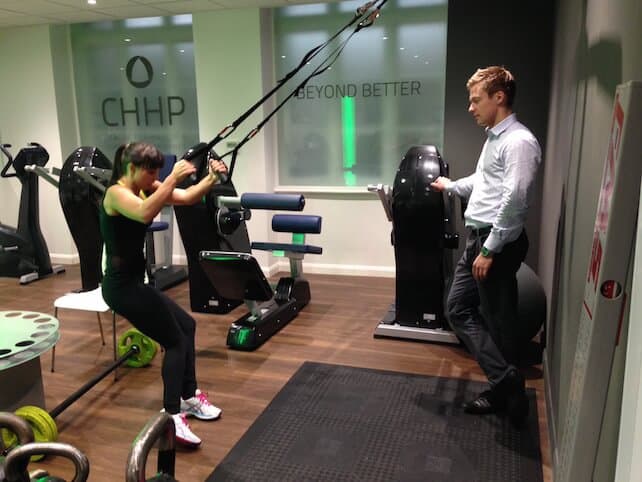
La Clinique du Sport
Based in Chamonix, this sports injury clinic offers physiotherapy and osteopathy treatment, rehab and prehab for sporting injuries, as well as sports massages, and tailor-made fitness courses. Director of Physiotherapy Neil Maclean-Martin has also developed the SkiFit fitness programme, available as a range of apps or an online programme. Free trials are available, and annual membership costs £9.99.
Spire
The hospital group offers ski fitness assessments at many of is branches throughout the UK, including Bristol, Leicester, Liverpool, and Tonbridge Wells. An assessment costs from £75.
For tips on healthy eating, see our feature on Ski Nutrition and How to Eat Well Skiing.










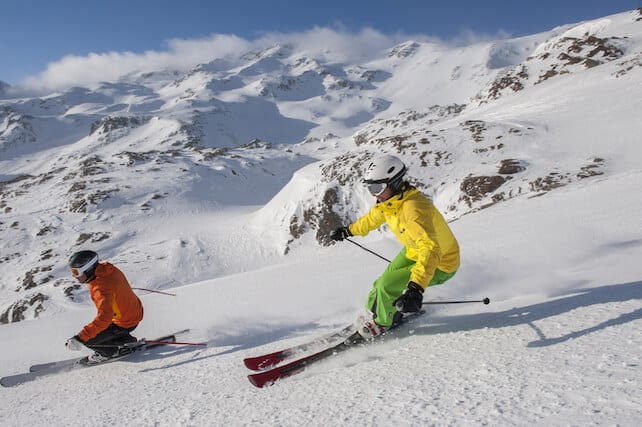
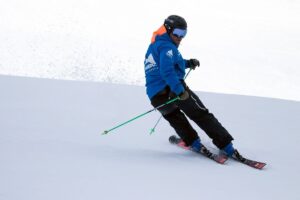
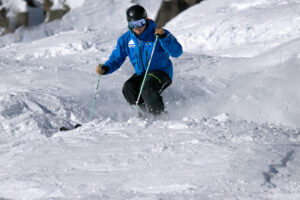
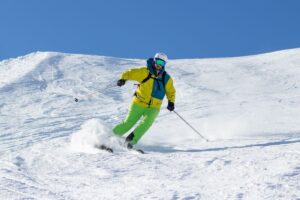
[…] a ski fitness programme that will enable your strength to build, your good fitness habits to develop and your stamina to […]
[…] a ski fitness programme that will enable your strength to build, your good fitness habits to develop and your stamina to […]
[…] a ski fitness programme that will enable your strength to build, your good fitness habits to develop and your stamina to […]